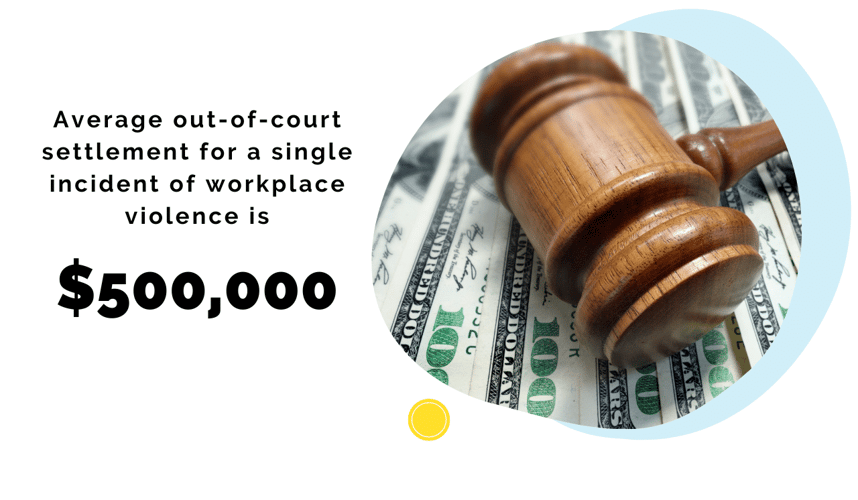
The Occupational Safety and Health Act of 1970 aims to “assure safe and healthful working conditions” under the law.
The truth is, today, no company is safe from workplace violence.
The term might sound distant, and people without firsthand experience often claim that workplace violence does not exist in their organizations, but it is something that occurs more often, and in more places, than one would think.
Defined as “violence or the threat of violence” against workers, workplace violence ranges from harassment, verbal abuse, workplace bullying, and physical assaults to homicide. Workplace violence can occur in a variety of circumstances, including but not limited to robberies, actions by frustrated clients and customers, actions by coworkers or former coworkers, and domestic incidents that spill over into the workspace.
In the US, roughly two million workers fall victim to workplace violence each year, and from the beginning of 2022 up till July 5th, more than 314 mass shooting incidents have already occurred.
With workplace safety and safety in general, becoming a growing concern, it is more crucial than ever for businesses to secure the means to protect their employees.
According to the Bureau of Justice Statistics, workplace homicides increased 11% from 2014 to 2019, averaging 1,000 cases per year. FBI’s data further shows that out of the 160 active shooter incidents from 2000-2013, over 80% occurred at work.
On top of these life-threatening incidents, there were more than 20,000 private industry workers who experienced trauma from some sort of non-fatal workplace violence in 2019, and this is just the data from those who spoke up.
According to the US Equal Employment Opportunity Commission, there are about 75% of workplace harassment that end up unreported. These numbers are troubling as they are, but perhaps a more pressing issue lies in the unawareness of businesses.
The big question is, are companies doing enough?

A recent survey reveals that around 50% of HR professionals say there’s been an incident of violence occurring in their workplace, but only 45% of American workers are aware of workplace violence prevention programs at their organizations. In other words, more than half of American employees are unfamiliar with the resources, protocols, and policies that protect their physical and mental health in the workplace.
This discrepancy between rates of violence and prevention creates an opening for higher risks and dangers for both employees and employers. In fact, a lack of safety measures not only compromises workplace safety but also costs companies great fortunes.
According to research conducted on over 50 workplace harassment cases, the average out-of-court settlement for a single incident of workplace violence is $500,000; if taken to court, the jury usually awards to victims an average of $3 million.
These costs for employers add up to a shocking approximate $121 billion annually, according to the Department of Justice and the National Institute for Occupational Safety and Health.
While some acts of violence are irrational, unpredictable, and thus unpreventable, there is more and more information regarding the causes of violent behaviors in the workplace that is coming to light. It is no longer enough to attach active shooter training to a fire drill or to use one short page in the employee handbook to address workplace bullying.
It is now possible and necessary for companies to develop an effective and comprehensive workplace violence prevention program that strives to establish an environment that is safe from violence, harassment, intimidation, and other forms of threats.
This program should consist of three parts:
- Development of a policy
- Establishment of safety protocols
- Relevant employee safety training
One of the most effective ways to prevent workplace violence is putting into place a zero-tolerance policy that covers all workers, clients, and anyone else who may encounter company personnel.
It is crucial for employers to understand that their reactions to reports of workplace violence greatly affect employee behaviors and can make or break their companies’ cultures. A strict and well-executed policy creates a bond of trust between employers and their employees, as the latter knows that if an act of violence or harassment occurs, there will be appropriate responses and real consequences for the offender(s).
On the other hand, it is also critical for employees to know how to recognize, handle, and report incidents of violent and threatening behavior.
This is done through establishing safety protocols and implementing them through company-wide training. When all employees are on the same page about what counts as unacceptable behaviors, what to do when they experience these behaviors, and the best measures to take when encountering a dangerous, hostile situation at work, they can work together to ensure a healthy, productive workplace and minimize the risks of violence.
We know it’s stressful for companies to worry about safety while facing other constant challenges, so we are here to help take that stress off your shoulders.
We invite you to watch our recorded webinar: Violence Prevention in the Workplace for more detailed guidance on building a reliable workplace violence prevention program that makes sense to your company.
While there is no certain way to prevent all workplace violence, we can help you minimize the risk, building a safe and healthy work environment, step-by-step.
This article is not intended to be exhaustive nor should any discussion or opinions be construed as legal advice. Readers should contact legal counsel for legal advice.
Topics:
.png?width=1125&height=426&name=Your%20paragraph%20text%20(5).png)
.png?width=500&name=watch%20the%20webinar%20side%20banner%20(1200%20%C3%97%201200%20px).png)